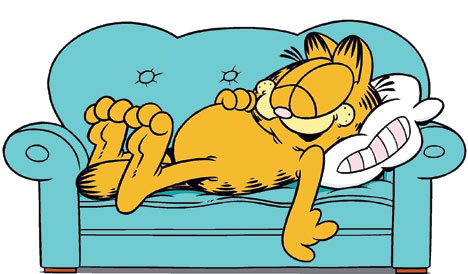

He’s still tubby but not as much as in the comic strip’s early days. It was to make him more expressive, mostly. At first his eyes were small and squinty, so it was hard for his eyes to show any emotion. I made them bigger, and the eyes can give away what Garfield’s thinking
© Paws. All Rights Reserved
Since 1978, “a fat lazy orange cat” named Garfield has been cracking jokes at his owner’s expense. He has been making fun of his owner’s other pet, a dog named Odie. Plates of lasagna and hamburgers are going down his hatch several times a day. And he hasn’t still fallen in love with Mondays. Come June 19, Garfield will turn 40 (he was born in 1978) and whatever is said about the big 4-O, he has no intention to change for anybody. The best thing is that he has helped Jim Davis, the comic strip’s 72-year-old creator, stay young at heart. The creator’s message to his creation, through t2oS? “Age happens, but maturity is optional! Keep on being your lovable self, pal.” Excerpts from the chat...

Why do you think Garfield remains so lovable and popular even after 40 years?
I’m not sure. I’m afraid if I studied it too hard it would go away. My best guess is that there are a lot of cat lovers out there, and I’d follow that with a contradiction by saying that Garfield is also very human. He loves to eat and sleep — very human traits we all share. Also, Garfield is an anti-hero. He defends our right to pig out, sleep in, and be selfish. He says and does the stuff we’d all like to say and do if we thought we could get away with it.

When and how was Garfield born?
Garfield was born in my sketchbook sometime in 1977. As far back as I can remember I wanted to be a cartoonist. Even during college, the dream of being a cartoonist never died. After college I took a job at an advertising agency, and then, in my first big “break”, I went to work as the cartoon assistant for Tom Ryan (Tumbleweeds). While I worked with Tom, I learned the discipline of being a syndicated cartoonist with a daily strip.
My first attempt at my own strip about bugs was called Gnorm Gnat. I tried and tried to get Gnorm syndicated. Finally, a comics editor at one of the syndicates took pity on me and said, “Your art is good. The jokes are funny. But bugs? Who can relate to a bug?” So, I looked at the comic’s pages to see which strips were working and discovered there were a lot of strips about dogs… Snoopy, Marmaduke, Belvedere... but no cats! So, I started doodling pictures of cats, and came up with the kind of cat I knew from my childhood — disinterested, aloof, and yet somehow completely in control.

© Paws. All Rights Reserved
You had several cats while growing up. What was home like?
I had a charmed childhood. There was a pond for fishing and swimming, trees to climb, and plenty of cows. It was hard work too. I started doing regular chores on the farm by the time I was 10. In fact, my brother and I couldn’t wait to be old enough to help Dad in the barn. My dad was a hard worker and he taught me the important life lessons: Work hard, be honest, take care of your family. If dad said, “Take two or three bales of hay to the barn”, he meant “four”. The manure from the barns was spread on the fields, and, after rotary hoeing, we weeded the corn rows by hand. My dad was the first farmer in the county to get over 100 bushels of corn per acre. The name Garfield came from my grandfather, James Garfield Davis. He was a big man with a grumpy, crusty wit but a heart of gold. He seemed gruff, but his eyes gave him away. He had the world’s largest laugh.

© Paws. All Rights Reserved
So, why does Garfield love lasagna so much and hate Mondays equally?
The truth is that I love lasagne, so I just figured, why not? And Mondays — I like Mondays, but most people don’t. The whole “return to the work week” thing. Since Garfield is basically a human in a cat suit, he hates Mondays.

© Paws. All Rights Reserved
How come the cat has lost a lot of weight over the years?
He’s still tubby but not as much as in the comic strip’s early days. It was to make him more expressive, mostly. At first his eyes were small and squinty, so it was hard for his eyes to show any emotion. I made them bigger, and the eyes can give away what Garfield’s thinking. Also, his body was sort of a big blob in the beginning, and it was awkward to make him walk on all fours, so his body got trimmed down, and his legs got longer.
Garfield doesn’t age. Do you think being a cartoonist helps you stay young at heart?
Yes, absolutely. My wife accuses me of acting like a 12-year-old. But, that’s okay with me.

© Paws. All Rights Reserved
Who did you model Garfield’s owner Jon Q. Arbuckle after? What does the “Q” in his name stand for?
The name Jon Arbuckle came from an old coffee commercial I remembered hearing. I’d also used the name as an “expert source” to add credibility to my speeches during debates in my college days. I don’t know why that name stuck with me. The “Q” comes from the American expression for the average guy, which is John Q. Public. Jon’s pretty average.
Besides the orange cat, which of your other characters did you enjoy creating most?
I really love Odie. He’s stupid but sweet, and for a character that doesn’t talk, he’s very expressive. It’s also fun to do strips with Jon Arbuckle’s parents and brother because they’re based on own family.
Having read Garfield for decades, one thing that strikes me is that none of the characters are black, except Harry, who’s a cat.
Many of the characters are based on my own family and I’m basically Jon Arbuckle. It’s not a conscious effort to exclude anyone — I suppose my excuse is that I work with what I know.
Also, there was a time when mailman Herman Post turned up often. In the age of the Internet, how’s he doing?
Herman was a character in the animated TV show, The Garfield Show. As far as I know, Herman is staying busy delivering packages for Amazon!

Any character that has disappeared from the Garfield universe in the 40 years?
Yes, there are several characters that have had one-time appearances, but the most notable is Lyman. He was Jon’s roommate in college and originally owned Odie. Lyman and Odie came to visit; Lyman left and Odie remained. Lyman’s primary function was to talk to Jon Arbuckle, but Garfield assumed that role. We don’t know what happened to Lyman — maybe he joined the Peace Corps.
1978 was when DC and Marvel were going strong…
Honestly, I didn’t pay that much attention to Marvel or DC at that time. Superhero comics were miles away from what I was trying to accomplish with Garfield.
There is simplicity in your drawing, something Peanuts creator Charles Schulz was also known for. How did you arrive at your drawing style?
My first teacher was my mother. As a kid, I had asthma; so I had to spend a fair amount of time in bed. My mom would hand me a tablet of paper and pencil and tell me to entertain myself. And I did. I drew pictures that were so bad; I had to put labels on them. I’d draw a cow and then label it “cow”. I didn’t realise it at the time, but I was becoming a cartoonist. Pretty soon, my abilities as an artist improved to the point that I didn’t have to label everything, but I found it was easier to make my mom laugh when I combined words and pictures. Sure, she was an easy mark, but her encouragement led me to where I am today — the “owner” of a fat lazy orange cat named Garfield. In terms of the simple style, Peanuts was my biggest inspiration. I loved the gentle humour and the simple line work. Schulz had a real knack for looking at the world through a kid’s eyes. Sparky (Schulz’s nickname) taught me the incredible power in the light-hearted treatment of the simple things in life.

Who are your comic heroes from childhood? And who do you like today?
Not necessarily in an order, but from my childhood, Milton Caniff (Steve Canyon), Charles Schulz (Peanuts), Mort Walker (Beetle Bailey), Walt Kelly (Pogo), and Johnny Hart (B.C.). Today, there are so many great web comics it’s hard to keep up, but Get Fuzzy by Darby Conley is hysterical and strange. Great characters and fascinating interaction between the characters. I also think Mutts by Patrick McDonnell is a wonderful feature. Its art is retro in style. It’s very bright and the timing is impeccable. I love Pearls Before Swine by Stephan Pastis, Mother Goose and Grimm by Mike Peters, Blondie by Dean Young, Baby Blues by Rick Kirkman and Jerry Scott, Zits by Jim Borgman and Jerry Scott… I could go on!
Do you have any tips for young artists?
To become a successful cartoonist, it’s important to read; read a lot. The more you read the more you have to say. Learn to draw well realistically. The better your characters are drawn, the more natural they will appear to be. Draw a lot. Chuck Jones, the great animator for the Road Runner series, said that every artist has 100,000 bad drawings in them. After doing 100,000 drawings, every drawing is going to be good! It’s simple; the more you draw, the better you get. When creating your comics, work with lots of different materials and try lots of drawing styles. Eventually, you’ll find a style that is uniquely yours. When you do your cartoons, relax and have fun. The more fun you have doing them, the more fun people will have reading them; something translates through. After school, get a job around art or around writing. It’s important to keep honing your skills as you look to find ways of making a living with your cartoons. Read a lot, draw a lot, have fun and you’ll do just fine!

Any comic strip/character from India you have enjoyed?
I’m probably most familiar with Chacha Chaudhary. Do you have some you’d like to recommend to me? I’m open to suggestions!
The late Charles Schulz decided to retire from drawing Peanuts at a certain point. But on the other hand, Asterix co-creator Albert Uderzo decided to hand over the baton to other artists and storytellers. Which is a better way of going about things?
It all depends on the artist. I’d like to see my kids and grandkids take it over someday, but maybe they won’t be interested. On the other hand, I work with a lot of talented artists who assist me on the strip. So, maybe… I’m not ready to quit yet, so hopefully when the time comes I’ll have a plan!
What’s a working day like for Jim Davis?
I’m an early bird. I usually get to the office by 5am. I read emails, answer correspondence, do approvals on new stuff coming in the door — products, scripts, or whatever it happens to be. I try to get most of my work done in the morning. If the day and the weather allow, I try to get in a game of golf.
WISE WORDS FROM OUR FELINE FRIEND
• I’m not overweight, I’m under-tall.
• I’ll rise, but I won’t shine.
• The meek shall inherit squat.
• All I do is eat and sleep. Eat and sleep. Eat and sleep. There must be more to a cat’s life than that. But I hope not.
• Eat every meal as though it were your last.
• I am hungry. Therefore I am.
• When the lasagna content in my blood gets low, I get mean.
• This is it. I’ve reached the pinnacle of laziness and gluttony.... How depressing. There’s no place to go after you’ve reached the top.
— Mathures Paul
Garfield is a lot like me because...
Tell t2@abp.in










